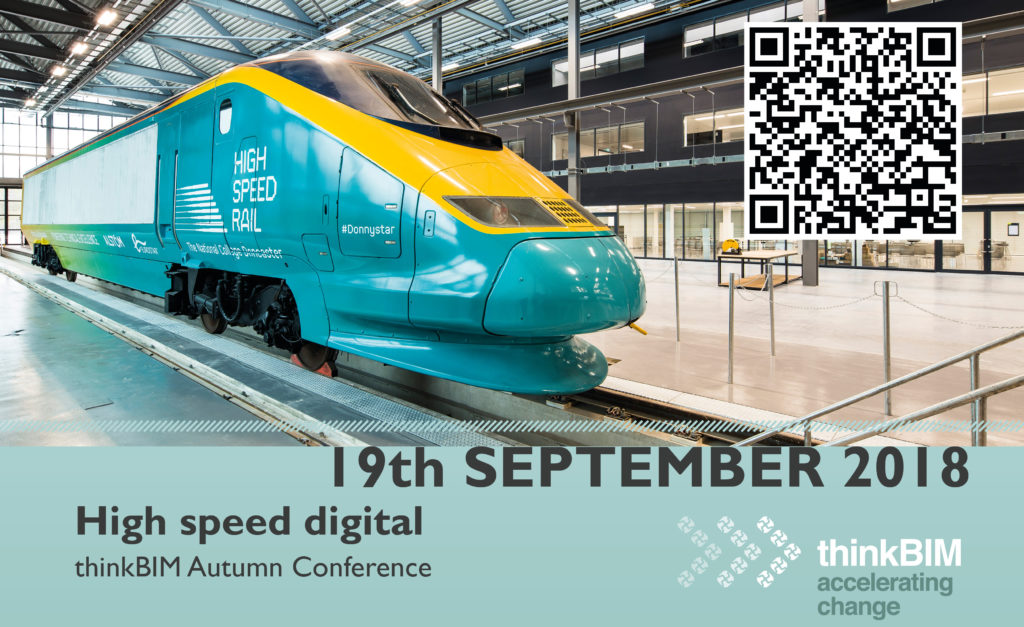thinkBIM – Beyond Design – Facility Management (First Published on NBS Blog)

The below article has been taken from the Construction Code Blog and was written by Stephen Hamil.
Today I attended the thinkBIM “Beyond Design” event. I scribbled this blog post down as the day progressed – so apologies for any for any grammar or spelling which is worse than usual… 🙂
First up was Deborah Rowland from the UK Cabinet Office. Deborah chairs the FM workstream reporting into Mark Bew and David Philp as part of the UK Government’s BIM Task Group.
The Government Soft Landings policy is out for draft at end of July and looking to be ready for September. Soft Landings has been around for many years, just not called “Soft Landings”.
When looking at after-care, they don’t want a “box of manuals”, sometimes they don’t even get a box of manuals. Traditionally this is something that is poor. So we need to focus on the handover documentation and then quality post occupancy evaluation so that we can have a feedback loop to influence the design next year.
One thing that is critical is that the BIM data/the COBie data feeds into the CAFM software tools for the FM professionals that already exist within the public sector and their supply chain partners.
Another critical item is to get the FM professionals involved at the briefing stages and to set the FM budget. To look at OpEx as well as CapEx. This will work best if the FM industry gets on board now.
Discussion at the end was around can the BIM software and CAFM software work together? But surely BIM is the process and the data flows between?
I then stayed with Deborah for her ’round table’. The first discussion was on how we can work backwards from the FM data to go back to the design team so they can set up their data with the occupier as the ultimate end user of the data. Deborah explained how the government trial projects will be monitored and lessons will be learned to tighten the processes over the next few years.
 |
| Deborah Rowland from the Cabinet Office |
The criticism of COBie is it is being perceived is that it is 100’s of thousands of lines of information about everything that is no use to everyone. When you buy a car, you want a nice concise car manual. Not a big spreadsheet of every property of every component. I personally see that there is a lot of confusion around COBie at the moment. My take on this is that there is a lot to be gained from clever software to hide this information behind the scenes. The software must then easily provide the information that is needed intuitively at the right time. Is there an analogy here with Google Maps? There is a huge, huge, huge amount of information hidden away – as you zoom in on a premise, then you get information you need (phone number, web address, reviews of food/service). We need the same for a building – zoom in on room, then system, then pipe – then get the spec. The user doesn’t need to care about the complexity behind the scenes.
The absolute fundamentals are 1. Receiving a good brief, 2. Designing to the brief, 3. Building to the design and then 4. Handing over well structure information so the building can be operated efficiently and future briefs can improve.
One of the big challenges will be keeping the model up to date. Three years to design, three years once complete – what will the data structures and software capabilities be six years from now?
Next item of question for Deborah is how hungry are the government to look at OpEx and not CapEx? Pay designers more, spend more on real quality systems and products – that is the way that real money is saved over 70 years. But “does a government with a 5 year term care about this?” Will they spend more in the short term? Deborah’s experience in the private sector says that you can reduce both by learning the lessons from previous similar buildings.
My conclusion on this is that we have three broad challenges:
- Where does the information come from?
- Can the software hide away this structured data so that you just get what you want when you need it?
- How is this data updated over the years – as soon as it goes out of date it’s useless.
What about post occupancy evaluation tools? All goes quiet. Educating the users is also important – don’t open the windows else the Air Con works twice as hard. Then change of subject – what about “crystal ball time”. Ten years down the line the building receives a major refurbishment and alteration. Can the structured data be round-tripped back into the design package and then merged together? Who knows?
For a big refurbishment job now, why not get a 3D cloud model instead of 2D – then use this as a base for the refurb work in the main design model. No real difference to new build? But if users already have existing CAD DWG files – will they really spend the money for the point cloud?
And after a quick tea break it was time for the second session. I chose the “BIM and Asset Management” with Jason Allen from IBM (BIM Lead in the Asset Management division) – Maximo is the main software package they use.
 |
| Jason Allen doing the roundtable – @EEPaul working the digital magic |
What information is needed for FM? And what information is not needed? “Is anyone out there actually handing over an as-built model that is full of data once construction is complete?” is the question. Nobody around thinkBIM Roundtable 3 is doing this. One suggestion is that at the end a point cloud survey is done. But this will just give the geometry surely? Who is putting the as-built data in?
When speaking about the Government MoJ trial project “Two cells and a corridor give 15,000 lines in an Excel spreadsheet” – surely this is not right? Ten type components with Fifty attributes each – it’s only 500 lines in a database? Maybe it’s the instance attributes that are bloating the model? If this is the case then some sort of consolidation is required to make sure the database/spreadsheet does not explode? Again, the confusion over COBie is definitely there at the moment. At NBS we are working on a sample integrated model showing this process off – it’ll take a month or two to finalise but I think it will really help.
Functionally what is needed is a big COBie button in ArchiCAD or Revit or Bentley which allows the users to specify what objects they wish to export – these have to be pre-linked to the spec – the many objects not in ArchiCAD/Revit/Bentley model but in the spec then need picked – then it generates a *concise* COBie database (Excel or openOffice or SQL or Access or XML) automatically.
To date there are currently two excellent resources for COBie 2012 UK:
What is COBie? http://www.bimtaskgroup.org/cobie-uk-2012/
- Example data drops – http://www.bimtaskgroup.org/cobie-data-drops/
James Allen suggests that the BIM and the FM database are not different things – it’s the same data just further down the line. The physical asset should even update this BIM as to how it is operating (energy use for example). Allows Asset Managers to actually monitor their portfolio of buildings.
It doesn’t matter where the data is – doesn’t matter which database it is in – what matters is that is all hooked off the “master model” through open standards. And then it was time for the adventurous bit – a live web stream from America from Marty Chobot VP of BIM Initiatives FM Systems in the USA.
 |
| @FairSnape makes the web streaming from the USA work |
What do owners really need? Again was the question that was asked. From design to construct to operate – the importance of the graphics diminishes and the importance of the attributes increases. Now the problem is that there is a ton of data out there. This information needs to be presented in a useful way to the client.
Marty then goes through a few BIM and FM case studies. For one facility it took two person years to digitalise the information they wanted. That’s not a fun task if it has already changed by the time you have finished. By integrating the FM information into a master BIM they calculated they could save 4-6 months Xavier uni asset management database.
Similar to the FM presentations at BIM Academy last month, the level of detail of the information you are going to store and *maintain* has to be agreed and pragmatically assessed. If you try and maintain too much information you will fail and it will go out of date.
MathWork’s Apple Hill 4 Project was the next case study – where a new building was being built with the intention of getting it perfect for digital information for FM. Marty suggests the same idea that was floated earlier in the day that the BIM deliverable to the operator needs agreed at day 1. Also identify what information is needed – what attributes for what systems and what components. Insist these are delivered and in what format (sounds a lot like the UK COBie iniative).
What really, really matters is that you agree your numbering and naming conventions early. Get the FM involved throughout. And look out for BIM savvy sub-contractors wherever possible.
The day always ends with Pecha Kucha. Three really nice ones from @StefanMordue from NBS, Jon Moorhouse from Constructive Thinking Studio and Olli Aro from Clicks and Links.
 |
| @StefanMordue – It’s not just hard FM (lollipop) but soft FM too (ice cream) |


